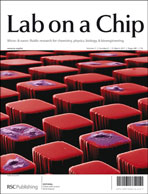Controlling the contents of microdroplets by exploiting the permeability of PDMS†
Abstract
A microfluidic device capable of exploiting the permeability of small molecules through polydimethylsiloxane (PDMS) has been fabricated in order to control the contents of microdroplets stored in storage wells. We demonstrate that

- This article is part of the themed collection: In memory of Chris Abell

 Please wait while we load your content...
Please wait while we load your content...